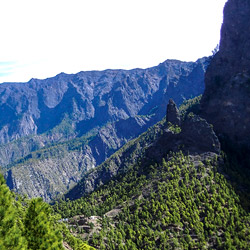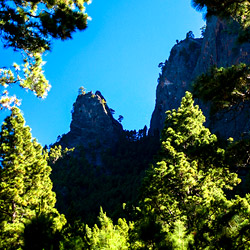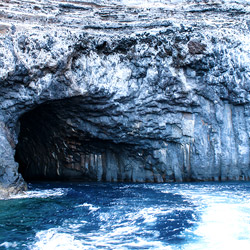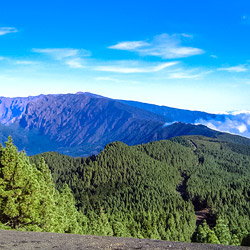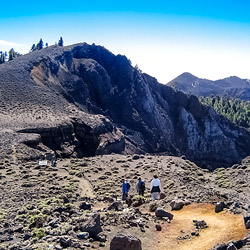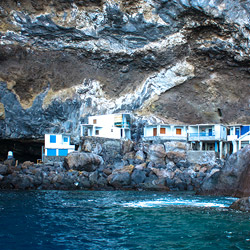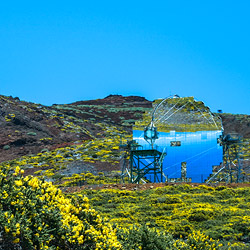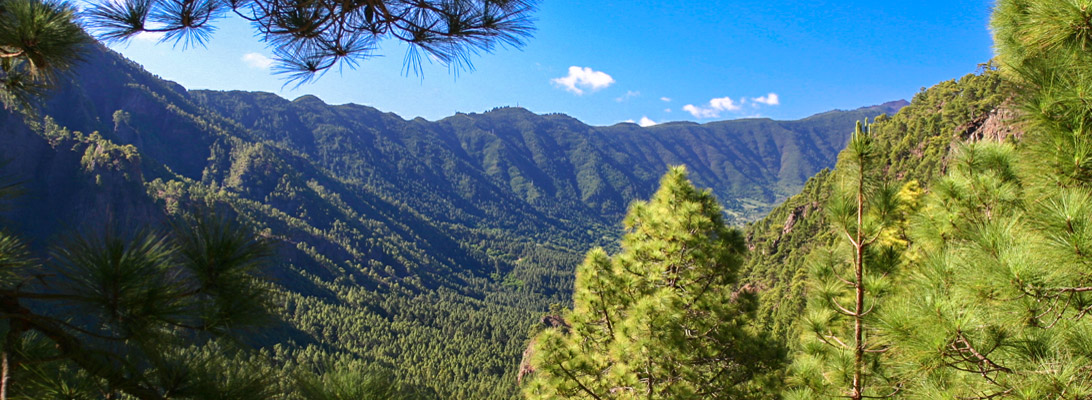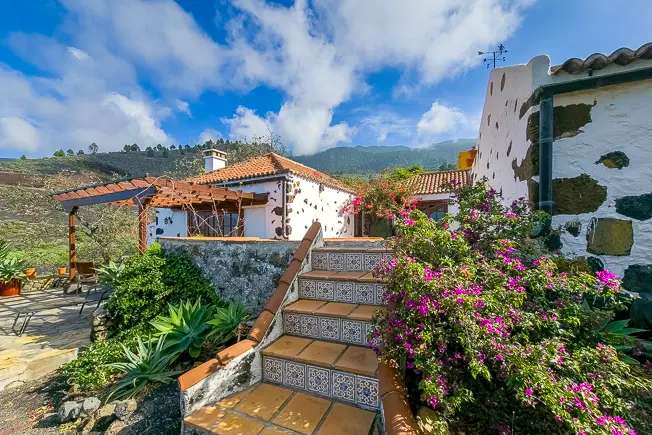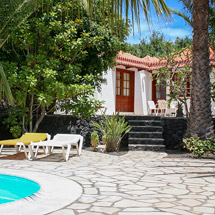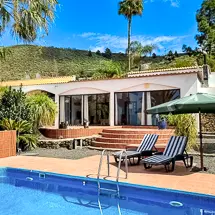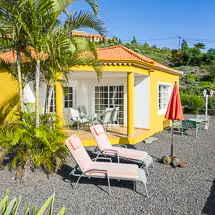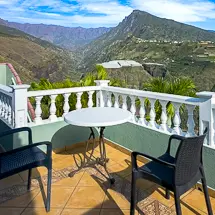Not only the nature is worth seeing on La Palma with volcanic craters, scree slopes, pine and laurel forests, mountain streams and canyons but also the cultural sights such as colonial towns and churches from the 16th and 17th centuries with wood carvings and paintings by Flemish artists can also be discovered in the smaller towns.
Archaeology, Museums, Arts and Crafts
In addition, there are the artistic legacies of the ancient Canarian Benahoaritas (Guanches), who carved drawings into the rock in exposed places in nature and produced beautiful black ceramics.
Also worth a visit are the numerous small museums, which provide information about former industries and production methods - whether silk, tobacco, mojo or gofiomuseum, the archaeological museums of Santa Cruz and Los Llanos exhibitions about arts and crafts everywhere in La Palma. Visitor centers and archaeological parks are just as much a part of La Palma's attractions as are the many designated viewpoints (Miradores).
Places, Highlights, Tours
We have highlighted special highlights on La Palma. Have a look around on our website in the most interesting places and look forward to your holiday on La Palma.
If you don't have much time, you may be inspired by our recommendations for car tours to see as much of La Palma as possible even during a short stay.
Highlights
The following La Palma-Highlights are from our point of view an absolute "must", at least for your first La Palma holiday:
Hiking the Caldera
The hike into the heart of La Palma requires good physical condition but rewards all your efforts with the unique natural experience it offers. Under no circumstances should it be started in bad or changing weather or shortly after heavy rainfall. The safest way is to go on an organized tour and never alone.
Accommodation in the Caldera de Taburiente
At the campsite in the Caldera de Taburiente hikers can visit the campsite after having received prior permission (available from the CalderaVisitor Centre). Everything you may need must be brought along with you. Many other areas of the Caldera may not be entered, and nature conservation for plants and animals are a top priority.
Starting points for walks in the Caldera
You can walk the Caldera from the car park in the "Barranco de las Angustias" (about half an hour by car from Los Llanos) or from the viewpoint Los Brecitos (only with an all-terrain car or by a jeep-taxi from the car park). A total walking time of 5 to 6 hours with short breaks is realistic for both options. Good footwear, which can get wet in the Barranco when jumping over stones in mountain streams, and hiking poles are highly recommended.
Dos Aguas, Roque Idafe and colored waterfalls
From "Barranco de las Angustias" you first hike uphill through the riverbed of the Taburiente to the confluence "Dos Aguas".
Past the incredible, colorful waterfalls and the volcanic chimney "Roque Idafe", venerated by the Guanches you will reach the campground via a strenuous ascent. You can go back the same way, because of the breathtaking views, which are offered in the opposite direction, guarantee that you won't get bored.
Cumbrecita
The Cumbrecita is a 1,287-metre high mountain saddle on the southern edge of the Caldera de Taburiente, from which you can overlook the entire basin. The most convenient way to reach the Cumbrecita is with a rental car. It can also be explored with a mountain bike. If you are on foot, the easy path, from the little church "Virgen del Pino", takes about 3 and a half hours. This viewpoint is one of the most popular in La Palmas.
In earlier years it was possible to drive up to the car park at the Cumbrecita at any time. But after overcrowding caused more and more of a chaotic situation, a barrier was installed at the entrance. Visitors must now register in the CalderaVisitor Centre and draw a waiting number. Only when a parking space is available and it's your turn, may you drive up.
Picnic with a view of the Caldera
The road to the Cumbrecita branches off at the CalderaVisitor Centre above El Paso and leads through light pine forests. On the way, you pass the shaded picnic area "Riachuelo". The view wanders over the whole Caldera and back to the Cumbre Nueva, which often boils over from clouds. Within a 15-20 minutes walk from the car park you reach the viewpoint "Lomo de las Chozas". A second vantage point, the "Mirador de Los Roques", is a little below the Cumbrecita (go back 200 meters from "Las Chozas" and take the small path on the left that leads down). A walk between both vantage points takes about an hour and requires good footwear.
A trip to the Cumbrecita can be combined with a hike to the "Mirador de la Cancelita" or to the Cumbre, a visit to the Caldera Visitor Centre, the Sanctuary "Virgen del Pino", or El Pasos.
Volcano Teneguia
The volcano Teneguía at La Palma's southern tip is volcanology that you can touch. On the lava slopes of Teneguía, which was formed in 1971, the earth's heat can still be felt under your feet. Here, at the youngest volcano of the Canary Islands, you can spend a whole day.
Information on the Marine Reserve
In the old lighthouse "Faro" is a visitor center about the marine reserve near La Palma. On a virtual dive, visitors learn all about the dangers of water pollution. In the salt works around the lighthouse sea salt is still extracted today.
Guanchen Drawings and Beaches
Near the Teneguía, at the Roque Teneguía, rock paintings of the Guanches were discovered. At the end of the visit, the day can end with swimming on the beach directly at the southern tip or at one of the nearby beaches. At Playa Echentive (Playa Nueva) the healing springs of Fuencaliente, which has been buried for more than 350 years, were rediscovered and is now to be opened up for tourism.
Los Tilos
One kilometer from Los Sauces, in the northeast of La Palmas, lies the Los Tilos Biosphere Reserve with its, up to 30 meters high, laurel forest, which has survived here since the Tertiary Age. Laurel is actually called "los tiles", but the place has established itself as "Los Tilos".
Hikes near Los Tilos
The starting point for a hike through the laurel forest is the visitor center, near which you can also stop to grab a bite to eat. The enchanted laurel forests are moistened by fog clouds and keep almost all of the sunlight out. Waterfalls, gorges, giant ferns, viñatigo trees, Canary holly, spurge, and others can be found on hikes and smaller walks at Los Tilos. Rain protection and sturdy shoes are a must. Hikes to the Barranco del Agua, to the "Mirador Espigón Atravesado", "Mirador de las Barrandas" or to the springs of Marcos y Corderos (which are very demanding, take a torch and rain jacket with you) can be made. During, or after rainfall, however, one should refrain from hiking.
Museo Naval
Located in La Palma's capital Santa Cruz this amazingly small replica of Columbus' flagship, with which he "discovered" America in 1492, was built of concrete in 1940 and houses the Palmeric Maritime Museum (Museo Naval). On display are ship models (including the German four-master "Pamir", which sank in 1957), nautical charts and instruments, books on seafaring and stuffed fish. An information sheet explains the most important exhibits. From the upper deck of the Santa Maria, visitors can enjoy a view of the Plaza de Alameda and the sea. Columbus was probably never on La Palma. He set off for the Caribbean from Gomera but a rumor among the locals still persists that he had a girlfriend on La Palma.
Open Mon-Thu 9:30 AM - 2:00 PM, 4:00 PM - 7:00 PM. Fridays and July to September 9:30 AM - 2:00 PM. Entrance 1,50 €, children free of charge.
Cueva de Belmaco
The cave at Mazo is part of an archaeological park and contains interesting rock paintings of the ancient Canarians (Benahoaritas). From Hoyos de Mazo, you can drive up to 1 km before Malpaíses, to the overhanging rock face, which probably served the tribe "Tigalate" as residence and king's seat.
Caves and rock paintings of the Guanches
Drawings dating back to the 10th century have been preserved. They depict spirals, wavy lines, but also human- and animal-like forms. A circular path leads over twelve stations. The dragon trees growing here give the site a primeval flair. In addition to the main cave, nine other caves belong to the complex. Some probably served as death chambers. The site was first discovered in the 18th century. A visitor center and museum with exhibited tools and archaeological finds are attached.
Opening hours Mo-Sa 10:00 AM - 6:00 PM, Sun 10:00 AM - 3:00 PM. Entrance fee 2 €, children 0,75 €.
Cueva bonita
This cave in the area of Tijarafe is called "pretty" (bonita) because of the play of colors of sunrays and reflecting waves in its rock curvature. This spectacle can be observed particularly well on a sunny late afternoon. Fishermen used to hide from pirates in these caves and while the pirates lurked in front of the entrance, the escapees made their way through a secret passage inside the cave.
Boat trips from Puerto de Tazacorte
The cave can only be reached by boat and the excursion takes about three hours, including a picnic and bath break, at a nearby beach. From Puerto de Tazacorte you can join organized boat tours when the seas are calm (e.g. catamaran "Fancy II"). With a bit of luck, you may be able to observe dolphins on your way there, or on the way back, along La Palma's rugged steep coast.
Ruta de los Volcanes
Starting from the picnic area, "Refugio el Pilar", you walk on the volcanic ridge of La Palma from north to south over ash fields and heaps, craters, and lava formations. Beautiful views of the coast and volcanic lunar landscapes make this hike (about 20 km), which requires some physical condition, something unique.
Once in a lifetime views of the volcanic peaks of La Palmas
After passing the summit of Pico Birigoyo (1.808 meters) and Nambroke (1.925 meters) it is worthwhile to have a closer look at the dark Hoyo Negro (Caution, danger of slipping at the craters rim!). Indestructible pines grow on the lava slopes and magnificent views open up. Next is the Duraznero (1901 meters), Deseada I and II. Deseada I is with 1949 meters the highest point of the tour.
Crossing the history of the island from north to south
Now it's only downhill towards Hoya de la Manteca and Volcan Martin, which erupted in the 17th century and from whose crater the view spreads out over a fascinating volcanic landscape. At the Fuente del Tión, the path turns into a dirt road that leads through pine forests to Los Canarios. Until Los Canarios, there are no places to stop for refreshments. Those who do not want to hike so much can turn back along the path and go back on the same way. The starting point can only be reached by rental car or taxi.
Smuggler's Bay
Below Tijarafe, a very steep road leads road down to the smuggler bay, to the rock overhang "Porís de Candelaria" with some weekend cottages and a daring bathing bay. Hikers recommend that you hire a car to cover the first steep stretch of road, as the descent and the subsequent ascent on the way back can otherwise be exhausting in the sun and heat. From the small parking lot above the bay, a 10-15 minute footpath leads down. Depending on which option you choose (you can read more about it in the Rother hiking guide, for example), you will pass tunnels, gorges and another bay (Play del Jurado) on this hike. On weekends many locals use the huts in the bay as weekend cottages, then it can be quite crowded there.
El Tablado
The town of El Tablado in the lonely north of La Palma (municipality of Garafía) is a highlight for all lovers of La Palma's north with its cliffs, Dragon trees, and lonely villages.
Mirador "El Fagundo"
On the road from Puntagorda to Barlovento take the steep, curvy turn-off to El Tablado. As there are hardly any parking possibilities in the village, you leave the car above the village at the restaurant "El Moral" or "Mirador El Fagundo" 400 meters further and follow the road on foot. Today, many of the abandoned cottages are used for rural tourism. Orange and dragon trees grow in the surrounding area.
View and bathing bay El Fajal
In El Tablado there is a simple bar and a shop. If you want to enjoy more of the atmosphere here, you can explore the neighboring bay of El Fajal with bathing facilities (in calm weather) on a one and a half hour hike. From "Mirador El Topo" at the end of the village you can enjoy a view of the steep coast and the surrounding Barrancos.
Observatory
The Roque de los Muchachos is home to one of the most important observatories in the world. Until the construction of an information center, which is already planned, it can only be visited on a few, quickly booked out open days in midsummer in half-hour guided tours in Spanish and German (Tel. 922-40 55 00: Information also available from the tourist information offices Santa Cruz and Los Llanos).
High-tech telescope at the Roque de los Muchachos
The clean air and high altitude make the Roque de los Muchachos the ideal location for a space telescope. Several European countries are working together to explore space. Today, so much data is automatically evaluated by computer and displayed directly on the screen to astronomers that one must say goodbye to the idea of being able to look over the shoulder of a stargazer at night on the telescope. Without explanation, the displayed results are not understandable for the laymen. If you are interested in more insider knowledge, you will find some old editions of "La Palma Info" with expert and easily understandable articles by an astronomer from Berlin.
Stars discovered on La Palma
In addition to the Newton telescope with a diameter of 2.54 meters and the Herschel telescope with a diameter of 4.50 meters, the 10-meter "Grantecan", composed of 36 flexible individual mirrors, provides new observations from space. In 2007, for example, two planets were discovered outside our solar system. One of these exoplanets was given the name "Garafía-1". A 15-meter high tower is used to observe the sun and its sunspots. There is even a heliport on the site. Several small beehive-like measuring stations were built to measure atmospheric radiation.







